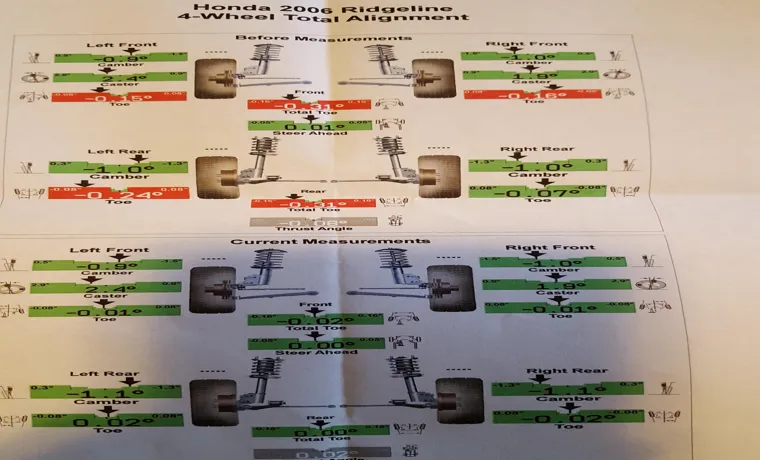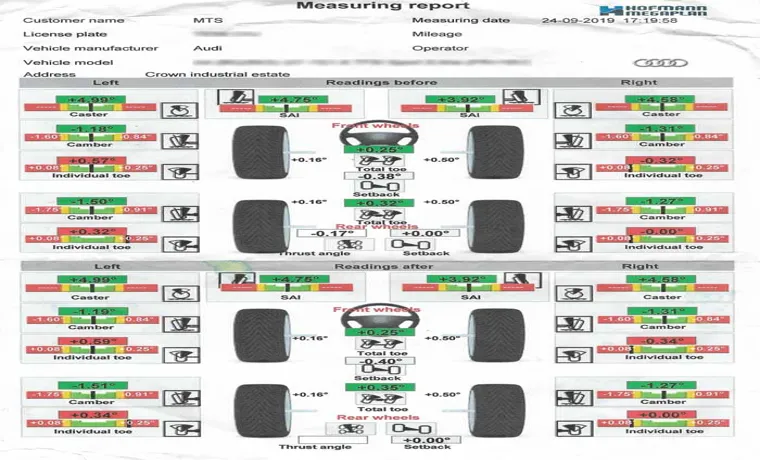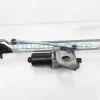Have you ever looked at your tire alignment report and felt completely lost? Don’t worry, you’re not alone. Reading a tire alignment report can be overwhelming and confusing for many people. But understanding how to read it is crucial for your safety and the longevity of your tires.
Think of it like a report card for your car’s tires. Just as you want to understand your child’s grades, you should want to understand your vehicle’s tire alignment report. In this blog, we’ll break down everything you need to know to read a tire alignment report and get a better understanding of your vehicle’s performance.
So buckle up and let’s dive in!
Table of Contents
Introduction
Are you confused about how to read your tire alignment report? Understanding tire alignment is crucial for maintaining the safety and performance of your vehicle. The tire alignment report displays data about your car’s camber, caster, and toe-in status, which are all essential components in keeping your tires aligned properly. The camber refers to the angle of your wheel, the caster is the pivot angle of your steering system, and the toe-in tells you the angle of your tires when viewed from above.
By reviewing your tire alignment report, you can accurately assess which areas need adjustments. It’s important to ensure that your tires are properly aligned to prevent uneven tread wear, improve handling, and increase fuel efficiency. If you’re unsure about how to interpret your tire alignment report, consult with a trusted automotive professional who can provide guidance.
What is a Tire Alignment Report?
A tire alignment report is a document that shows the results of a tire alignment check or service. It details the current status of various suspension and steering components and indicates whether they are correctly aligned or not. This report is an essential aspect of vehicle maintenance, as correct alignment can affect various mechanical components’ wear and tear.
It helps vehicle owners understand the issues that may be causing their car’s odd handling or poor performance, such as uneven tire wear or steering wheel vibration. A tire alignment report includes a detailed description of the car’s alignment measurements and any adjustments made during the service. This document provides crucial information that drivers can use to avoid potential issues that can lead to expensive repairs down the road.
So, it’s essential to get a tire alignment report from a reputable mechanic or auto service center whenever you need an alignment check or service.

Why is it Important to Read a Tire Alignment Report?
Tire Alignment Report When it comes to maintaining your vehicle, getting a tire alignment is crucial. It not only ensures the longevity of your tires but also enhances your driving experience. Upon completion, your mechanic will present you with a tire alignment report, a document that outlines the current state of your vehicle’s suspension and alignment measurements.
But why is it important to read this report? Well, for starters, it can give you valuable insight into the condition of your vehicle’s steering and suspension systems. By understanding the specifics of the report, you can see if there are any issues that need to be addressed, such as worn-out components or broken parts. Ignoring these issues can lead to further damage or even dangerous driving conditions.
So, take the time to thoroughly read and understand your tire alignment report to ensure the safety and performance of your vehicle.
Understanding the Key Information in the Report
Learning how to read a tire alignment report is essential if you want to keep your vehicle running safely and smoothly. At first glance, the report may seem confusing with all the numbers and diagrams, but a little bit of understanding can go a long way. The report typically includes information on camber, caster, and toe, which are all settings that affect how your tires make contact with the road.
Camber refers to the inward or outward tilt of the tire, caster relates to the angle of the steering pivot, and toe measures whether the tires are pointing inward or outward. By understanding how these settings impact your vehicle’s handling and performance, you’ll be able to better assess whether your current alignment is optimal or requires adjustment. So, if you’re wondering about how to properly read a tire alignment report, don’t hesitate to consult with your mechanic.
They can walk you through the report and provide the necessary guidance to keep your vehicle running safely and efficiently.
Camber
Camber is an essential feature of any vehicle’s suspension system. It refers to the angle and direction of the wheels in relation to the road and the vehicle’s body. When the wheels are tilted inwards or outwards at the top, it is called negative or positive camber, respectively.
The purpose of camber is to distribute the weight of the vehicle evenly across the tires, ensuring maximum contact with the road. This improves handling and grip, especially during cornering and braking. Camber also affects tire wear, with excessive negative or positive camber causing uneven wear on the inner or outer edges of the tires.
It is essential to keep the camber within the recommended range to ensure optimal performance and longevity of the tires. The camber angle can be adjusted by a mechanic using specialized tools, depending on the vehicle’s make and model. Understanding camber is vital for any vehicle owner, as it directly affects the safety and performance of the vehicle on the road.
Toe
If you’ve ever experienced pain or discomfort in your toe, you know how frustrating it can be. There are a variety of reasons why your toe might be bothering you, including injuries, infections, and underlying medical conditions. Understanding the key information in a report about your toe can help you determine the best course of action to take for relief.
This might include receiving medication, undergoing surgery, or simply resting your toe to allow it to heal. Whatever the case may be, it’s important to pay attention to your body and seek medical attention if necessary. So, if you’re experiencing any discomfort or pain in your toe, don’t hesitate to seek out the help you need.
Caster
Casters are essential components of various machines, from carts to industrial applications. The caster report offers valuable insights into the global market’s dynamics and trends. This report enables manufacturers to make informed decisions on production levels and supply-chain strategies.
In essence, the caster report covers a wide range of factors, including market size, regional outlook, market share, and growth rate. It highlights the current market scenario and predicts future market trends. Also, the report covers various market segments such as heavy-duty, light-duty, and medium-duty casters.
It provides an analysis of the competition within this industry, including companies like Colson Group, Tente International, and Blickle Wheels. Manufacturers can use this data to benchmark their products against others in the industry and identify areas for improvement. Overall, the caster report offers a comprehensive understanding of the market dynamics, helping manufacturers to make informed decisions.
Thrust Angle
Thrust angle is a critical component of vehicle dynamics, affecting everything from steering control to tire wear. Essentially, it refers to the angle between the vehicle’s longitudinal centerline and the direction of travel. When a vehicle’s thrust angle is off-center, it can cause the wheels to scrub, leading to uneven tire wear and potential driveline damage.
Additionally, it can make the vehicle feel unstable when driving in a straight line, as the wheels may be fighting against each other. Car manufacturers typically recommend an acceptable range for thrust angle, and it’s important to check and correct any misalignment to ensure optimal performance and safety on the road. Overall, understanding and monitoring thrust angle is critical for any vehicle owner or driver looking to maintain their car’s long-term reliability and handling.
Interpreting the Results
Once you’ve received your tire alignment report, it’s important to know how to interpret the results. The report will typically include measurements for the three main angles – camber, caster, and toe – and will show whether they are within the recommended range for your vehicle. The camber angle is the tilt of the wheel inwards or outwards, the caster angle is the inclination of the steering pivot, and the toe angle is the angle between the longitudinal axis of the wheels and the centerline of the vehicle.
If any of these angles are outside of the recommended range, it can lead to uneven wear on your tires and potentially affect your vehicle’s handling and safety. It’s important to note that some adjustments may not be possible due to damage or worn parts, and additional repairs may need to be made before the tire alignment is performed again. By understanding how to read your tire alignment report, you can ensure your vehicle is operating safely and efficiently on the road.
What Do the Numbers Mean?
When reviewing data analytics, it’s important to know how to interpret the results. Understanding what the numbers mean is critical to drawing accurate conclusions and making informed decisions. The first step is to look at the overall pattern of the data and identify any trends.
This can help you understand how the data is changing over time or how it’s impacted by certain factors. You also need to consider the variability or scatter of the data, as this can indicate whether the results are consistent or not. Another important factor is the level of statistical significance, which measures how likely the results are due to chance.
By understanding these key elements, you can make data-driven decisions that are based on sound analysis and insights.
Identifying Issues with your Alignment
If you’ve recently had an alignment or suspect that your car’s alignment is off, it’s important to identify and address the issue as soon as possible. Knowing how to interpret the results of your alignment can help you identify any problems and make necessary adjustments. One of the most common issues with alignment is uneven tire wear, which can result from a variety of factors such as driving on rough roads or hitting potholes.
If your alignment is off, you may also notice your vehicle pulling or drifting to one side while driving, which can be dangerous. It’s important to have your alignment checked regularly by a professional mechanic and to address any issues as they arise, to ensure the safety and longevity of your vehicle.
Conclusion
Reading a tire alignment report may seem daunting, but fear not! With a little understanding of the numbers and symbols, you’ll be able to decipher this document like a pro. Just remember, it’s all about making sure your tires are happy and healthy. Think of it like a spa day for your wheels – a little alignment goes a long way towards ensuring your ride is smooth and enjoyable.
So take a deep breath, crack open that report, and get ready to give your tires the TLC they deserve!”
FAQs
What is a tire alignment report?
A tire alignment report is a document generated by an auto shop that shows the current alignment settings of your vehicle’s tires.
Why is a tire alignment report important?
A tire alignment report is important because it helps you understand the current state of your car’s tires and can indicate if there are any issues that need to be addressed.
How often should I get a tire alignment report?
It is recommended to get a tire alignment check every 6,000 miles or when you feel any steering or handling issues while driving.
What information can I expect to see in a tire alignment report?
A tire alignment report typically includes details about the camber, caster, and toe angles of your car’s wheels, as well as any adjustments made during the alignment process.
How can I read and understand the tire alignment report?
Reading a tire alignment report may seem complicated, but it typically includes diagrams and charts that make it easier to understand. Your auto shop can also explain any information you may not understand.
What can cause my car’s tires to be out of alignment?
Things like hitting a pothole, curb, or other objects on the road, and general wear and tear on your vehicle’s tires and suspension system can cause your car’s tires to be out of alignment.
What are the signs that my car’s tires may be out of alignment?
Signs of a tire alignment issue include uneven tire wear, drifting or pulling to one side while driving, and vibrations in the steering wheel while driving.




